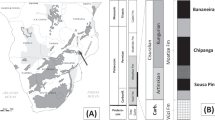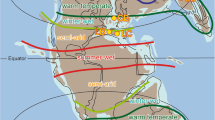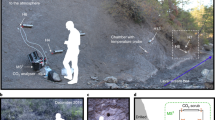Abstract
Various interpretations of D/H ratios in coals have been suggested1–4. The factors most likely to influence these ratios seem to be: (1) prevailing climatic conditions and the related deuterium contents of available fresh water (precipitation) during plant growth; and (2) the fractionation of stable hydrogen isotopes during both plant growth and subsequent sediment maturation. On theoretical grounds, the global distribution of the hydrogen isotopes in precipitation is expected to favour an increased deuterium concentration at the Equator relative to the poles. Published measurements of the D/H ratio in present day precipitation at different latitudes, as shown in Fig. 15, follow this trend. Clearly the well-established global variation in the isotopic composition of precipitation with regard to both climate and latitude provides a reasonable explanation for the differences observed in D/H ratios for coal from different continents as has been proposed for coals from Germany and South Africa1, and for isotopic variations seen in peat2. The D/H ratios for Australian coals reported here are consistent with their respective latitudes of deposition predicted from continental drift and hence the implied dependence on palaeoclimate.
This is a preview of subscription content, access via your institution
Access options
Subscribe to this journal
Receive 51 print issues and online access
$199.00 per year
only $3.90 per issue
Buy this article
- Purchase on Springer Link
- Instant access to full article PDF
Prices may be subject to local taxes which are calculated during checkout
Similar content being viewed by others
References
Schiegl, W. E. & Vogel, J. C. Earth planet. Sci. Lett. 7, 307–313 (1970).
Schiegl, W. E. Science 175, 512–513 (1972).
Redding, C. E., Schoell, M., Monin, J. C. & Durand, B. in Advances in Organic Geochemistry, 1979 (eds Douglas, A. G. & Maxwell, J. R.) 711–723 (Pergamon, Oxford, 1980).
Smith, J. W., Gould, K. W. & Rigby, D. Org. Geochem. 3, 111–131 (1982).
Dansgaard, W. Tellus 16, 436–468 (1964).
Smith, B. N. & Epstein, S. Pl. Physiol. 46, 738–742 (1970).
Yapp, J. C. & Epstein, S. Nature 297, 636–639 (1982).
Rigby, D., Batts, B. D. & Smith, J. W. Org.Geochem. 3, 29–36 (1981).
Embleton, B. J. J. in Paleoreconstruction of the Continents. Geodynamics Series 2, 77–92 (American Geophysical Union, 1981).
Norton, I. D. & Sclater, J. G. J. geophys. Res. 84, 6803–6830 (1979).
Author information
Authors and Affiliations
Rights and permissions
About this article
Cite this article
Smith, J., Rigby, D., Schmidt, P. et al. D/H ratios of coals and the palaeolatitude of their deposition. Nature 302, 322–323 (1983). https://doi.org/10.1038/302322a0
Received:
Accepted:
Issue Date:
DOI: https://doi.org/10.1038/302322a0
This article is cited by
-
Oxygen isotope dating of the Australian regolith
Nature (1988)
Comments
By submitting a comment you agree to abide by our Terms and Community Guidelines. If you find something abusive or that does not comply with our terms or guidelines please flag it as inappropriate.



